
Over the years, I’ve spent a reasonable amount of time with military surplus firearms. Initially, Trapdoor Springfield, 1917 Enfield and 1903 Springfield rifles were being sold for a few dollars each at discount retail stores and the Gun Control Act of 1968 was still more than a decade away. In fact firearms like the 30 Caliber Krag, the M1 and the M1 Carbine were readily available along with huge supplies of inexpensive ammunition. Times changed… quickly.
Fast forward, the next time I spent a good deal of time with military surplus weapons probably began 15 or 20 years ago. This time, projects had a predominantly European and Asian firearm focus; an Interesting learning and shooting experience that, unfortunately, ran out of steam about 2 or 3 years ago. After refurbishing a few rifles and handguns and building some retro sporters with others I found the repetition of task to be tedious and boring.
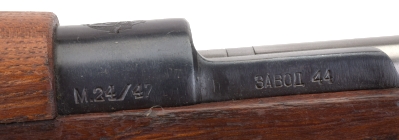
Pictured is my last Mauser. It is an m.24/47, produced from salvaged and newly manufactured parts sometime during 1947 in what was once Facility 44, the Military Technical Institute at Kragujevac, Serbia. One of 10,935 such firearms, it is not a matching serial number rifle, although the indications are that the majority of restrikes and mismatched numbers occurred at the time of refurbishing rather than the result of a recent scavenger hunt by importers… but the bent bolt handle suggests someone was playing fast and loose with a short barrel cavalry M24 bolt somewhere in the process.
| M.24/47 | |
| Manufacturer | Serbian Government |
| Type | Mauser M.24/47 |
| Type | Intermediate M98 |
| Caliber | 7.92x57mm (8mm Mauser) |
| Mag Capacity | 5 |
| Barrel Length | 23.24″ |
| Rifling | 1:9.4″ RH 4 Groove |
| Weight – Actual | 8 Lbs 13 Oz |
| Overall Length | 43.3 “ |
| Stock | Walnut |
| Length of pull | 13.5″ |
| Sights | Adjustable Front & Rear |
| Scope Mount | No accommodation |
| Trigger | 2 stage / 8 Lbs 11 Oz |
| Safety | 3 Position Wing |
| l | |
Details of the M24/47 require some research. If you are a gun board denizen, this is where you start shrieking like a teenage girl “Branko says…”, but I look at understanding history a little differently. For me it takes period documents and consensus of sources: the 1957 Mauser Bolt Action Rifles by Ludwig Olson… now in its fifteenth printing, the 2005 Serbian and Yugoslav Mauser Rifles by Bogdanovic, the 1996Mauser Military Rifles of the World by Robert W.D. Ball, and the 1991 The Mauser Bolt Actions by Jerry Kuhnhausen.
Typically a concurrence of fact emerges amongst experts, offering assurance so, like everyone else, I can cherry pick the “facts” that agree with my preferences and theories, ignore or dismiss the rest, and state my positions on the Internet as an expert.
The facts… at least to the degree I actually care
The M24/47 is a variation of the M98 Mauser design. The front receiver ring is the same diameter as a large ring M98 at 1.410″ with a 1.100″ barrel shank, but the length of the action is 8.500 “, and the front ring is 0.250″ shorter than a standard large ring M98 Mauser. The magazine length is 3.232″, or 0.083″ shorter than a standard M98, but long enough the make a comfortable home for the 3.228” 8mm Mauser cartridge.
The Mauser action is heat treated, however, there is a difference between a case hardening and a through hardening heat treat process. According to Kuhnhausen, the M98 Mauser receiver’s low/medium carbon steel is the equivalent of AISI 1035 and 1036 steel, heat treated to 33C to 35C, typically to a depth of 0.010″ to 0.015″. Low to medium carbon steel, below 0.25% carbon in content, is typically case hardened by adding carbon to the material’s surface when heat treating. Medium carbon steel, 0.25% to 0.5% carbon content and high carbon steel, 0.5% to l.0% are typically through hardened. Why is any of this of consequence?

The receiver is tough, but not brittle. In verified good condition, the M24/47 can handle current factory 8x57mm ammunition… the key word being “verifiable”. Made from lower carbon steel, Mauser actions can also be re-heat treated if desired, although I am not sure to which final dimensions it would aspire. Running handloads that are too hot can cause lug setback and excessive headspace and eventual structural failure. Popular Mauser action reworks, like contouring the rear receiver ring to provide a surface for scope mounting removes the case hard finish and exposes surface soft metal.
A military Mauser is not built to the higher standards of commercial Mausers, pre or post war, and quality of Mauser material, process and levels of quality control vary with date of production or refurbish and location. The M24/47 program yielded good quality military Mausers that require a good deal of process and machine work to be made into a quality sporting firearm. The current CIP Pmax is 3900 BAR (56,551 PSI) – For 0.323″ Groove Rifles. The current SAAMI MAP spec for the 8mmx57mm is only 35,000 PSI as it attempts to consider modern 0.323″ bullets finding their way into a handful of pre 1903 Mausers with a groove diameter of 0.318″. In doing do, SAAMI robs the 8x57mm of any reasonable level of performance with a SAAMI bullet weight / velocity standard for the 8mm Mauser of 170 grains and only 2,340 fps.
A drone view of the Mauser…
Like the modern marketing of features that touts a 3 position safety, the old time Mauser has the same. I’ve installed horizontal wing safeties because they clear low mounted scopes, but the original is very effective and the wing locks into a groove in the rifle’s firing pin to prevent it from moving forward, even if burped and bumped.
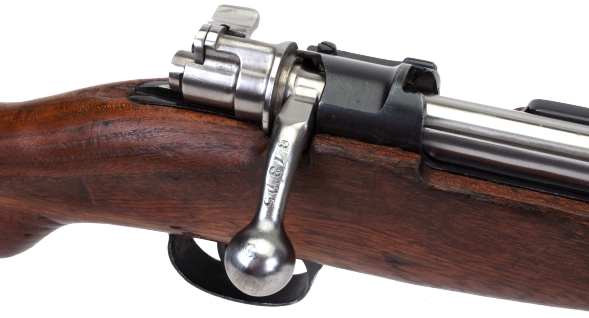
This bent bolt handle was typically reserved for short barrel models that saw cavalry service where compact form was important. It was not done to clear a scope as there are no facilities on this rifle to accommodate scope mounting. Yes, there were special model produced for sniper work with a scope, but the military didn’t put 10,000 down turned bolts on rifles in support of nonexistent scopes.
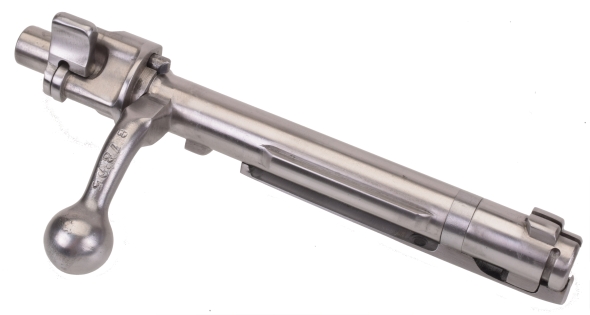
The bolt has a non-rotating claw extractor that plays into the controlled round feed system, two forward locking lugs, one aft and the rifle cocks on open. Bolt lift is 90º.
This stock is walnut, no side sling mount holes were plugged, the bottom sling swivel was the original placement on this stock. The lighter handguard was installed somewhere and at some time. Judging from the color of the wood, probably in recent years.
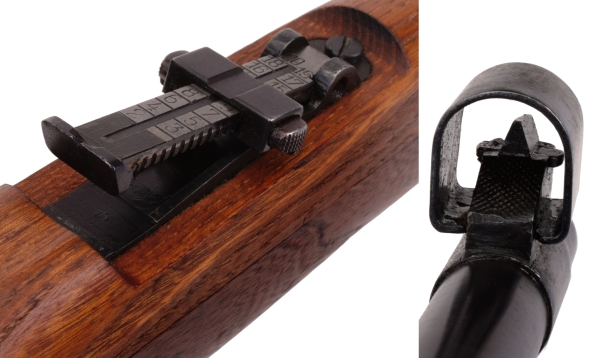
The rear sight is a tangent sight; moving the slider on the leaf pushes tangentially against the ramp on the mount and elevates the leaf for distant shooting. The scale on the leaf indicates that it is calibrated for distances of 100 to 2000 meters in one hundred meter increments. The front sight is ramped, hooded and horizontally drift adjustable. They are actually relatively precise when shooting in good light, against a relatively light backdrop. Only the top of the front sight pyramid shows in the tiny V notch of the rear sight. Align them over a dark or black target and they disappear.
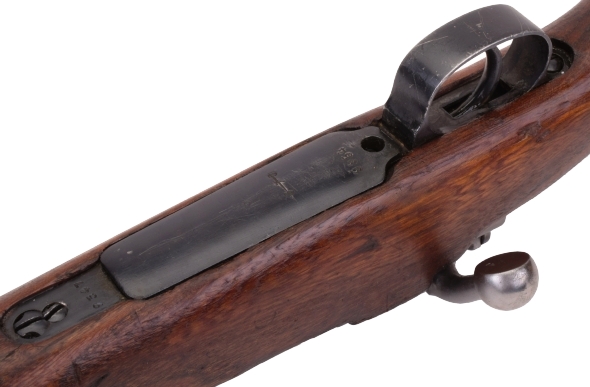
The mismatched, heavy bottom metal and dual lock head fasteners don’t look like much, but a gunsmith handy with a file can shape these pieces into something much lighter and sleek. This old metal takes a terrific blue. The trigger is a bit like pulling on the hook of a heavy wire clothes hanger; it is two stage and heavy. Triggers can be reworked until smooth and light and there are numerous replacement triggers. For me, I just clean them and learn how to shoot the rifle as it is. I’d rather develop the skill to shoot any rifle handed rather than modify every rifle I was handed.
From my perspective, there is way too much emotion affixed to these firearms. In original shape, they are as crude as any other military firearms of the period, the actions are not particularly strong, and while some folks will drag them around in the woods for deer hunting, they were never intended for this purpose and are a quite lousy fit for that application. So why do people go Mauser whacky?

When the appreciation was more pragmatic, the Mauser represented a potential to be converted into a slick sporting rifle and adaptable to a myriad of cartridges. However, the current effort and cost of modification make them far less desirable than any number of designs that already have many of the features missing from the Mauser. Why have Mausers been popular in more recent times? They have been inexpensive to collect and shoot and they are something affordable for people to talk about.
Historically, they were used in many settings, under many circumstances because they were a good, reliable military design and in wide spread use. Overall, the subject rifle is put together well, the action is smooth but tight and the 4 groove bore is in excellent condition. Handloads are being assembled and Part II is in the works with live fire results and anything we trip over on the way.

Email Notification